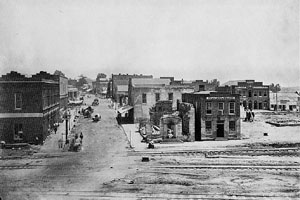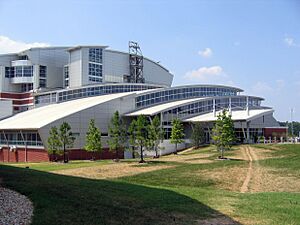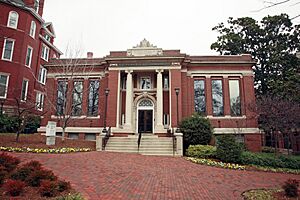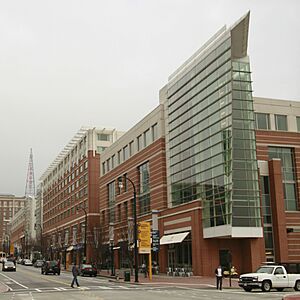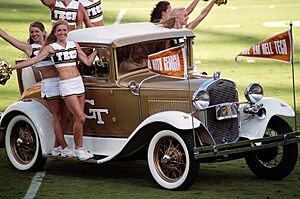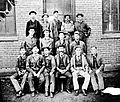Georgia Tech facts for kids
 |
|
|
Former name
|
Georgia School of Technology (1885–1948) |
|---|---|
| Motto | "Progress and Service" |
| Type | Public research university |
| Established | October 13, 1885 |
|
Parent institution
|
University System of Georgia |
| Accreditation | SACS |
|
Academic affiliation
|
|
| Endowment | $2.97 billion (2021) |
| Budget | $2.74 billion (2024) |
| President | Ángel Cabrera |
| Provost | Steven McLaughlin |
|
Academic staff
|
1,309 (fall 2022) |
|
Administrative staff
|
8,594 (fall 2022) |
| Students | 47,961 (fall 2023) |
| Undergraduates | 19,516 (fall 2023) |
| Postgraduates | 28,445 (fall 2023) |
| Location |
,
,
United States
33°46′34″N 84°23′46″W / 33.776°N 84.396°W |
| Campus | Large city, 400 acres (1.6 km2) |
| Other campuses |
|
| Newspaper | Technique |
| Colors | Gold and white |
| Nickname | Yellow Jackets |
|
Sporting affiliations
|
NCAA Division I FBS – ACC |
| Mascot |
|
 |
|
The Georgia Institute of Technology, often called Georgia Tech or just Tech, is a public university in Atlanta, Georgia. It is a special type of school called a research university and an institute of technology. This means students and professors do a lot of research to invent new things, especially in science and technology.
Founded in 1885, Georgia Tech is part of the University System of Georgia. It also has smaller campuses in other places, like Savannah, Georgia, and Metz, France.
The school was started after the Civil War to help the Southern United States build a stronger economy based on industry. At first, it only taught mechanical engineering. Over time, it added more subjects like electrical and civil engineering. In 1948, it changed its name from the Georgia School of Technology to the Georgia Institute of Technology to show it had become a top school for technology and research.
Today, Georgia Tech has seven different colleges and is a leader in science and technology education. The university's sports teams are called the Yellow Jackets and have won five national championships.
Contents
History of Georgia Tech
How the School Began
After the Civil War, many leaders in the South wanted to build more factories and industries. Two former Confederate officers, Major John Fletcher Hanson and Nathaniel Edwin Harris, believed the South needed a technology school to catch up with the industrial North.
In 1882, Harris led a group to visit schools in the Northeast. They liked the model of the Worcester Free Institute of Industrial Science (now Worcester Polytechnic Institute). This model combined learning in the classroom ("theory") with hands-on work in shops ("practice").
On October 13, 1885, Georgia's governor signed a bill to create the new school. A man named Richard Peters donated 4 acres of land in Atlanta for the campus. This land was once used for forts to protect Atlanta during the Civil War.
The Early Years
The Georgia School of Technology opened in 1888 with two buildings. One building, now called Tech Tower, had classrooms. The other was a shop where students could make things. This showed that learning with your mind and hands were both important.
In 1905, U.S. President Theodore Roosevelt visited the campus. He gave a speech on the steps of Tech Tower about how important technology education was for the country.
The school started an evening program in 1912. In 1917, it allowed its first female student, Annie T. Wise, to attend the evening school. She graduated in 1919 and became the school's first female teacher the next year.
Becoming a Modern University

The school officially changed its name to the Georgia Institute of Technology in 1948. This new name showed its focus on advanced science and research.
In 1952, President Blake Ragsdale Van Leer allowed the first female students to enroll in regular classes. In 1961, the school welcomed its first three African American students: Ralph A. Long Jr., Lawrence Williams, and Ford C. Greene. Georgia Tech was one of the first universities in the Deep South to integrate peacefully, without a court order.
During the 1996 Summer Olympics in Atlanta, Georgia Tech's campus was used as the Olympic Village for the athletes. Many new buildings were constructed for the games, including the swimming and diving center and new apartment-style dorms. This helped modernize the campus and the surrounding area.
On April 1, 2009, G. P. "Bud" Peterson became the 11th president of Georgia Tech. Under his leadership, the university was invited to join the Association of American Universities, a group of top research universities in North America. In 2014, Georgia Tech started offering a full master's degree in computer science completely online.
Exploring the Campus
The Georgia Tech campus is in Midtown Atlanta. Even though it's in a big city with skyscrapers nearby, the campus has a lot of green space and feels more like a park. The campus is divided into a few main areas.
West Campus
West Campus has many of the student apartments and dorms. It is also home to the Georgia Tech Campus Recreation Center, where students can work out, swim, and play sports. There is a large green field called the Burger Bowl where students can relax or play games.
East Campus
East Campus is where most freshmen live in dorms. It is also where the fraternity and sorority houses are located. Bobby Dodd Stadium, where the football team plays, and McCamish Pavilion, the basketball arena, are on East Campus. A famous landmark is "Freshman Hill," a steep hill that students walk up to get to the center of campus.
Central Campus
Central Campus is the heart of the university. It has most of the classroom buildings, research labs, and offices. The main library and the John Lewis Student Center are also here. The Student Center is a popular spot with a food court, game room, and movie theater. Next to it is the Kessler Campanile, a tall tower with a fountain that is a symbol of the school.
Technology Square
Technology Square, or "Tech Square," is a modern area of campus located across a major highway. It connects the university to the city of Atlanta. Tech Square has the Scheller College of Business, a hotel, and many restaurants and shops. It is also home to research buildings where students and professors work with companies on new technologies.
Satellite Campuses
Georgia Tech has other campuses besides the main one in Atlanta.
- Georgia Tech Savannah: Located in Savannah, Georgia, this campus focuses on professional education and research.
- Georgia Tech Europe: Located in Metz, France, this campus offers master's and Ph.D. programs in engineering and computer science.
Student Life at Georgia Tech
Georgia Tech students have many opportunities for fun and learning outside of class. There are hundreds of student clubs, arts groups, and sports teams to join.
Student Activities
There are over 500 student organizations at Georgia Tech. The Student Government Association (SGA) is the official student government, which helps fund many of these clubs.
Students can also get involved in media. WREK is the student-run radio station, broadcasting at 91.1 FM. The Technique is the official student newspaper, which has been published since 1911.
Arts and Culture
The School of Music at Georgia Tech has many groups for students to join, including the Georgia Tech Glee Club, which was founded in 1906. The Georgia Tech Yellow Jacket Marching Band performs at football games and other events. It has over 300 members and is known for its exciting performances.
DramaTech is the campus theater group, which has been putting on plays since 1947. The Ferst Center for the Arts hosts many professional music, theater, and dance shows throughout the year.
Greek Life
Georgia Tech has a large Greek community with over 50 fraternities and sororities. These organizations offer students a chance to make friends, participate in social events, and do community service. About one-third of undergraduate students are members of a Greek organization.
Georgia Tech Athletics
Georgia Tech's sports teams are called the Yellow Jackets. They compete in the NCAA Division I and are part of the Atlantic Coast Conference (ACC). The school's official colors are old gold and white.
The school has two mascots. Buzz is a costumed student who looks like a yellow jacket. The other mascot is the Ramblin' Wreck, a 1930 Ford Model A Sport Coupe. The Wreck leads the football team onto the field before every home game.
Georgia Tech's biggest rival is the University of Georgia. The annual football game between the two schools is a major event known as Clean, Old-Fashioned Hate.
Famous Fight Songs
Georgia Tech's main fight song is "I'm a Ramblin' Wreck from Georgia Tech." It is one of the most famous college fight songs in the country. It has been played in space and has appeared in movies.
Another popular song is "Up With the White and Gold." The lyrics include the line, "Down with the Red and Black," which is a reference to the colors of the rival University of Georgia.
Famous People from Georgia Tech
Many famous and successful people have attended Georgia Tech.
- Jimmy Carter, the 39th President of the United States, studied at Georgia Tech before going to the U.S. Naval Academy.
- Kary Mullis, a scientist who won the Nobel Prize in Chemistry.
- Mike Duke, the former CEO of Wal-Mart.
- Calvin Johnson, a famous football player known as "Megatron" who played for the Detroit Lions.
- Chris Bosh, a professional basketball player who won two NBA championships with the Miami Heat.
- Bobby Jones, a legendary golfer who founded the Masters Tournament.
- John Young, an astronaut who walked on the moon during the Apollo 16 mission.
Images for kids
-
The Kessler Campanile is a famous landmark on campus.
-
A view of the campus from nearby. You can see Bobby Dodd Stadium in the front.
-
The Georgia Tech Yellow Jacket Marching Band performing at Bobby Dodd Stadium.
See also
 In Spanish: Instituto Tecnológico de Georgia para niños
In Spanish: Instituto Tecnológico de Georgia para niños


